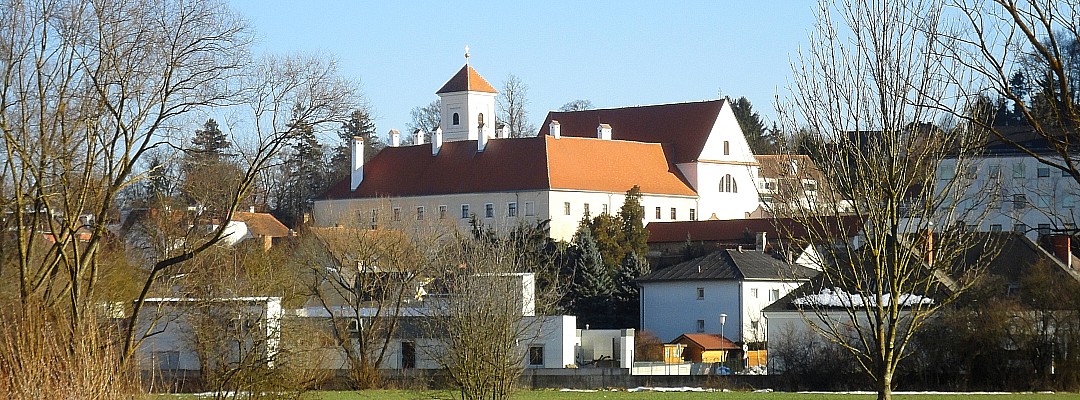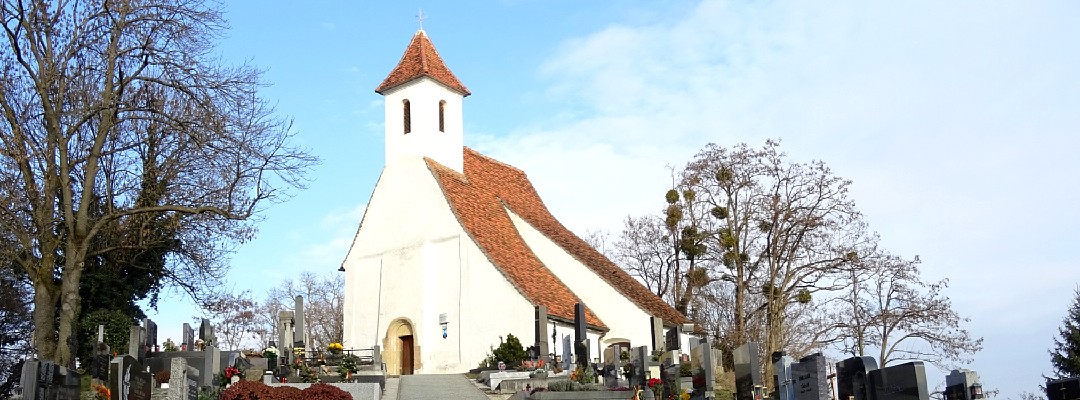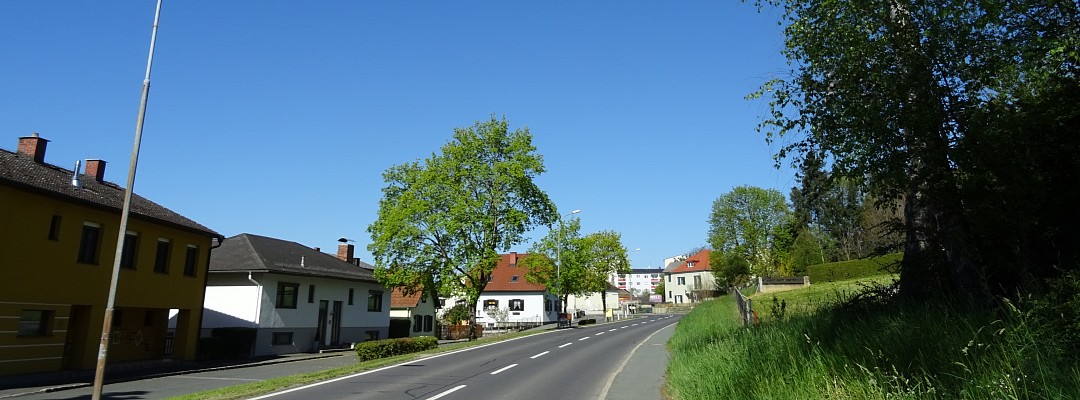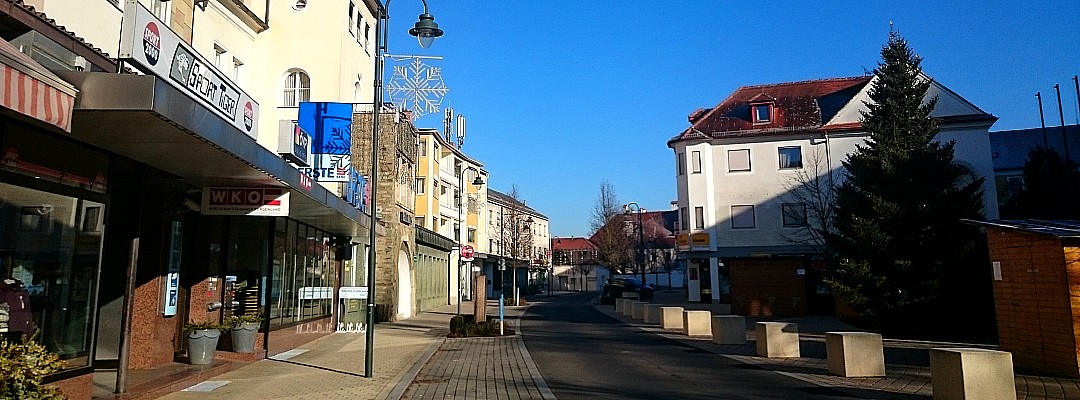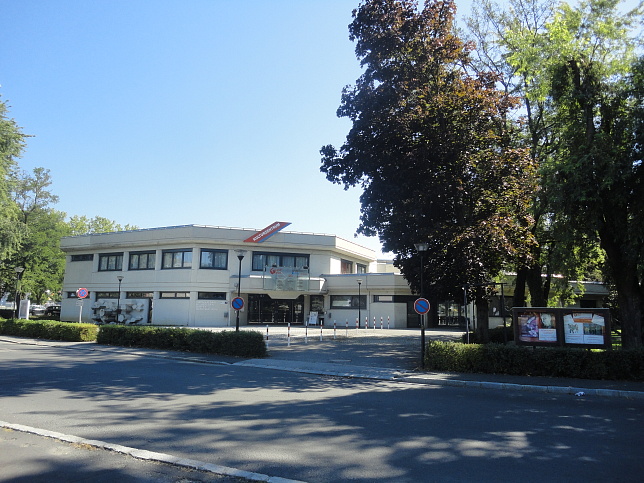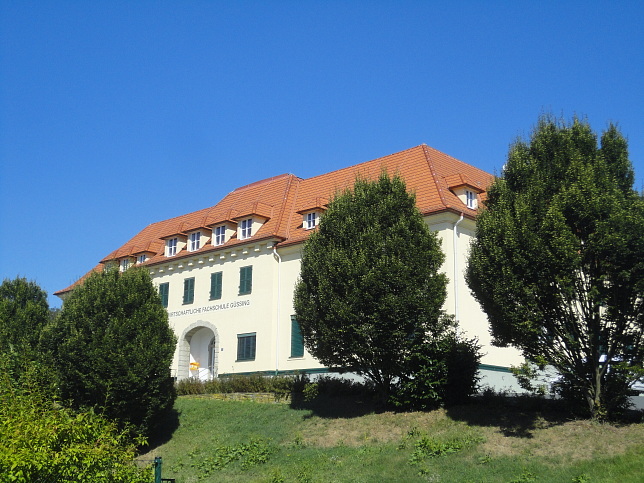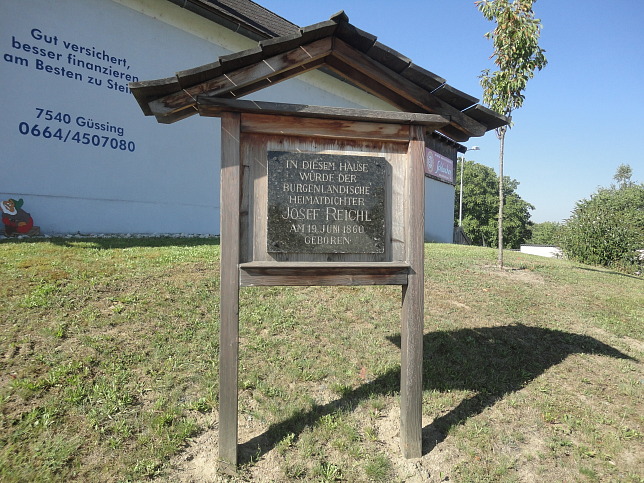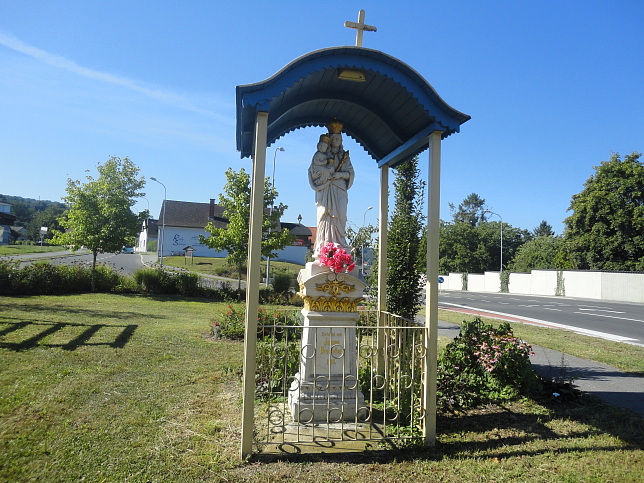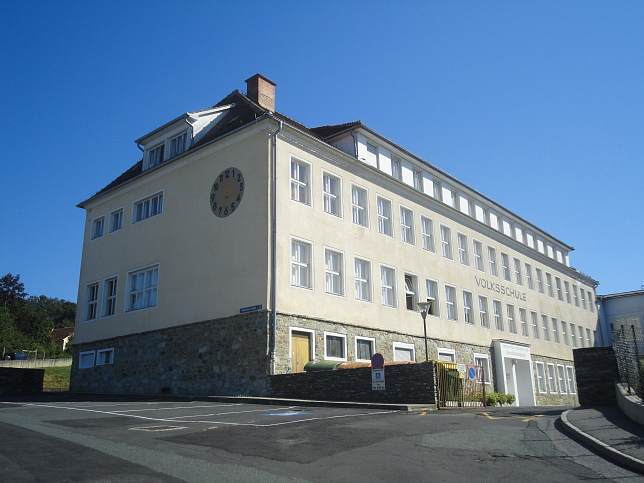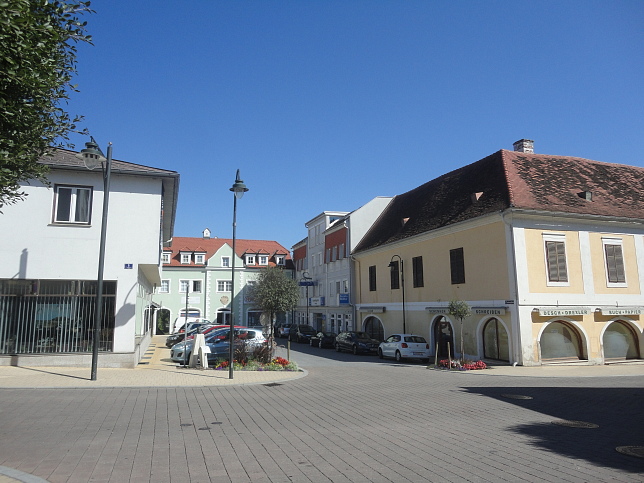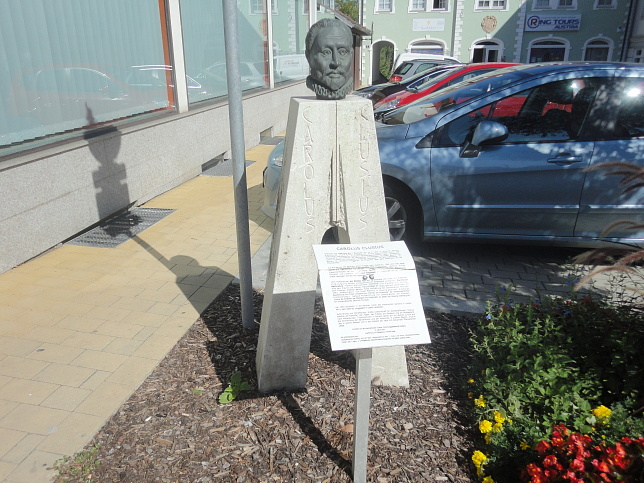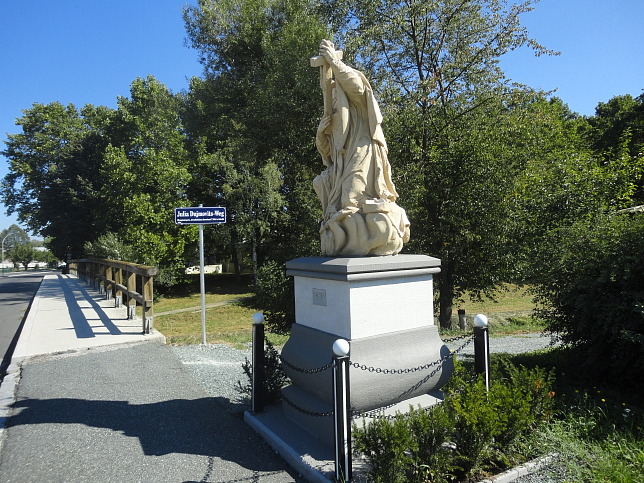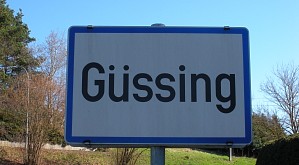
Güssing
Güssing (Hungarian: Németújvár, Croatian: Novigrad), is a town in Burgenland in Austria and is located on the B 57, the capital of the district of Güssing.
Culture and Sightseeing: The main attraction of the district town is the castle of Güssing situated on a volcanic cone with the exhibition "400 years of art", the Gothic castle chapel - with a neo-Gothic main altar carved out of wood as well as a very old chest organ and a baroque side altar -, the castle museum and the castle restaurant. On the grounds of the cemetery is the Romanesque town parish church, built around 1200. At the foot of Güssing Castle are the Güssing fish ponds.
In the village there is a Franciscan monastery, which at that time was also a corner bastion of the town wall.
The church Maria Heimsuchung (built around 1638) has numerous architectural Renaissance elements. Remarkable are the parament shrine in the sacristy and the valuable library with many unique items from the Protestant period. Under the church there is the family crypt of the Batthyány family. It is the second largest of its kind in Austria with a magnificent coffin by K. Moll.
In the village there is a two-storey, castle-like arcade building with beautiful stucco work. To the east of the town is the classicist castle of the Draskovic family with Empire furnishings and a Gothic winged altar from 1450 in the castle chapel.
Güssing was already a cultural centre 500 years ago. The theatre has always been of great importance. The Burgspiele are a fixed point in the summer cultural programme. In 2006 two productions took place in the castle courtyard: "Der Sommernachtstraum" (Midsummer Night's Dream) in the production of Frank Hoffmann (July) and "Der Verschwender" (The Prodigal) in the production of Erhard Jungnikl (August). In September, students of the Güssinger Gymnasium have been performing well-known musicals together with students from Hungary for several years. Also the historical town festival in August - usually held around August 15th - attracts thousands of visitors every year.
Personalities:
Ignaz von Batthyány (1741-1798), Egrian canon and bishop of Transylvania
Heinz Janisch (* 1960), author of children's books
Otto Kery (1923-2006), theatre director, director and actor
Michael Miksits (* 1981), soccer player
Martin Stranzl (* 1980), soccer player
Peter Traxler, cabaret artist ("Muckenstruntz Bamschabl")
Josef Trinkl (1951-2004), politician
Ägidius Zsifkovics (* 1963), theologian and church politician
Franz Faludi (* 1704 - 1779) Renewer of the national Hungarian literature and language
Josef Reichl (* 1860 - 1924) dialect poet
Renewable energy: Under Mayor Peter Vadasz, the city developed an energy concept for independent and sustainable energy generation in the early 1990s.
As a measure for economic development, the European Centre for Renewable Energy Güssing (EEE) was founded with EU funding. This was intended to create jobs in the region and to slow down the outflow of purchasing power through energy imports. In recent years, renewable energies based on electricity, heat, wood gasification and biofuels have made it possible to produce energy worth 20 million euros. In 2005 Güssing produced more electricity and heat with renewable raw materials than the city itself needs.
The power plant with wood gasification in Güssing also includes a pilot plant which produces a diesel-like fuel from the product gas by means of Fischer-Tropsch synthesis.
Cycle path: The cycle path B 61 - Wildparkradweg and the B 60 - Burg Güssing cycle path lead through the town.

from YOUNG STONE AGE
YOUNG STONE AGE from the 5th millennium BC:
Numerous early historical finds in the area of Güssing - stone axes, hole axes, etc. - point to an early settlement of our region.
METAL TIMES from the 1st millennium BC:
Findings from those times: lance tips on the castle hill Güssing, Celtic silver coins from the Iron Age, as well as gold coins; tumuli in Urbersdorf, Strem, Krottendorf, Güssing, and others).
ANTIQUE Roman province "Pannonia" from 15 B.C.:
At this time Güssing belongs to the less important hinterland of "Claudia Savaria", today's Szombathely (Steinamanger) - Hungary. Although no historical source testifies of a Roman settlement in Güssing, this is supported by the discovery of a Roman gravestone slab, from the 1st century AD, in the monastery garden of the Franciscan monastery.
The translation of the inscription on the gravestone plate reads: "Here lies the 55 year old Claudia Quarta (belonging to the Claudian colony Savaria). Her son, the citizen Claudius, had this tomb built. The latter, who died at the age of 80, also lies here." Migration.
Longobards and Ostrogoths are passing through our land.
MEDIUM AGE of 6th century:
Settlement of Slavic peoples under Avar patronage.
After the defeat of the Avars Güssing is part of the Frankish universal empire.
9th century:
Bavarian-Frankish colonization.
10th century:
Magyar storm; after its defeat 955 - border guard line of the Hungarians.
11th and 12th century:
First major German settlement period
12th century:
Border castles are built on the Styrian-Austrian border.
1140 - 1150:
Count Wolfer and his brother Heinrich found the family of the "Counts of Güssing". Wolfer was assigned the mountain "Kiscen" on which he had a wooden castle and a monastery built. The probable construction time of the castle and the "Jakobikirche" is around 1150.
The Benedictines founded an abbey and built the fortified monastery "...de Monte Quizin".
2. Hälfte 12th century:
King Bela III (*1148, +1196) of Hungary abolishes the monastery and deprives Wolfer's son Güssing (around 1180). With the monastery included in the royal fortress, the "New Castle" (Novum Castrum) was to form a counterweight to the Riegersburg and the fortified Fürstenfeld.
at 1220
The castle is in the possession of Count Demetrius of Csak - until his death.
1241/42
The plant defies the onslaught of the Tartars (Mongols).
1247
Bela VI. (*1206, +1270) calls the Order of St. John to Güssing.
at 1250
An intensified expansion of the castle takes place.
1273:
The castle withstood the attacks of Ottokar of Bohemia.
at 1270 - 1300:
Great expansion of power of the counts of Güssing (with Güns as their ancestral seat), who once again acquire the fortress of Güssing. Under Iwan (died 1308) and his brothers the greatest development of power took place - sovereignty aspirations and raids at the borders.
1289/90:
"Güssinger Feud", The "perfect tyrant" Iwan is defeated in three campaigns by the Habsburg Duke Albrecht (*1255, + 1308) of Austria; the fortress of Güssing is taken by Berthold von Emmerberg. After a brief Habsburg possession the dominion once again falls into the hands of the counts of Güssing.
1327 - 1391:
The castle and its dominion were owned by the Hungarian Crown.
1336:
King Karl I. Robert (*1291, +1342) of Hungary, from the House of Anjou, finally ends the power of the Güssing family.
1391:
King Sigismund hands over "Kyzung" to his commander Ladislaus of Saro ("of Leva") and receives two other castles in return. In the document of 1391 all estates which belonged to Güssing Castle are mentioned for the first time: the town of Güssing, as well as another 25 villages of which 5 already had market rights - Rauchwart, Heiligenkreuz, Deutsch Kaltenbrunn, Stegersbach and Rudersdorf. Under Peter Cseh von Leva (son of Ladislaus) the dominion experienced enormous wealth.
1458:
Nikolaus Ujlaky (member of the Habsburg party in Hungary) takes possession of the castle.
1459:
Emperor Frederick III (*1415, +1493) is born at Güssing Castle of 25 west Hungarians. Magnates are elected king of Hungary and thus counter king to the Hungarian king. King Matthias Corvinus I (*1443, +1490). The conspiracy breaks down. Ujlaky pays homage to the Hungarian. King. After the death of Ujlaky's son Lorenz, Güssing falls to the Hungarian Crown.
MODERN AGE:
1500/10:
Foundation of the Augustinian monastery in Güssing.
30.6.1524:
Ludwig II King of Hungary and Bohemia transfers Güssing to Franz I. Batthyany and his nephew Christoph. In the following century the southern Burgenland and some areas of western Hungary came into the possession of the Batthyany family.
16. und 17. Jhdt.:
Batthyany are carriers of the defensive fight against the Ottomans (Turks) at the "Kanisian border" between Lake Balaton and the Drava.
1526:
Francis I. Batthyany fights the Turks at Mohacs. King Louis II falls on the battlefield. Batthyany's loyalty to Duke Ferdinand I of Habsburg (*1503, +1564) is rewarded with the transfer of Schlaining and Rechnitz to Batthyany.
ab 1529:
Settlement of Croats in the areas around Güssing.
1530:
Croatian settlement in Hasendorf.
1762:
Sultan Soliman II. devastates the dominion Güssing.
1538:
PROTESTANTISM, Luther's teaching in Güssing.
1539:
Croatian settlement in Sulz.
1540 - 1580:
Removal of a large part of the outer castle fortifications.
1545:
Croatian settlement in St. Nikolaus (1631 mentioned as an independent community; as well as Krottendorf).
um 1568:
Pest, foundation of the monastery library; Balthasar Batthyany (*1542, +1590) founds the monastery library in Güssing (today it contains about 3484 exhibits). Carolus Clusius (Charles de l'Ècluse, *1526, +1609), works as a botanist at the court of Batthyany.
1570:
Balthasar Batthyany becomes a Protestant. The new teaching spreads unhindered to all possessions.
ab 1576:
Stephan (Istvan) Beythe is called to Güssing as court preacher. Afterwards also Calvinian preachers. A Protestant school is built in the former Augustinian monastery.
1582 - 1585:
The protestant itinerant printer Johannes Manlius is active in Güssing.
1588, 1595:
Pest
1595 - 1597:
Johannes Manlius is again active in Güssing.
1603:
Franz II. Batthyany (*1570, +1625), patron of the Protestants and hero in the battle against the Turks is raised to the rank of count.
1604:
Körmend comes to the "Güssinger Herrschaft".
1605:
Bocskay uprising: Güssing becomes a robbery of the flames.
1621:
Pest
1629/30:
COUNTER-REFORMATION, Adam Batthyany becomes Catholic.
1632:
The subjects are to be led back to the Catholic faith by the Jesuits.
1634:
Monastery and church are destroyed. All Protestant. Clergymen must leave the Güssing estate.
1638:
Franciscans come to Güssing.
arround 1640:
Count to the dominion Güssing 72 villages.
1644:
Acquisition of the dominion of Bernstein with Pinkafeld.
1648:
Foundation of the Franciscan monastery by Count Adam Batthyany.
7.4.1652:
Solemn consecration of the church by Johann Püsky, Archbishop of Kalocsa and Bishop of Györ According to the consecration document, the high age was consecrated to the glory of God, the Blessed Virgin Mary of the Visitation and all saints. The next day, April 8, 1652, the consecration of the two side altars took place in honour of St. Francis of Assisi and St. Anthony of Padua.
1662:
Adam's sons Christoph (*1637, +1687), founder of the older (princely) line and Paul (*1639, +1674), founder of the younger (count's) line share dominion Güssing, Schlaining, Rechnitz and Bernstein.
1664:
Battle against the Turks near Mogersdorf under General Raimund Prince Montecuccoli (*1609, +1680) in which also the Batthyany brothers were victorious.
1683:
Although Christoph Batthyany and his son Adam II. pay homage to the Turks, they join Counts Draskovich and Nadasdy under the imperial troops in their pursuit.
1703 - 1709:
Franz II. (count's line) is loyal to the emperor during the Kuruc Uprising.
Kuruzzen: Hungarian rebels called themselves Kuruzzen ("bearers of the cross") from the 15th century onwards. During their uprising under Franz II Rakaoczi against the Habsburgs, parts of Lower Austria, as well as Burgenland and eastern Styria (in the Lafnitz, Raab and Pinka area) were attacked and devastated several times from 1703 until 1709. The centre of defence was Güssing. Until 1711 occupation of the area.
1709:
Pest
1713:
Pest
1741:
Count Ludwig Ernst Batthyany (*1696, +1765) moves Hungarian magnates in Pressburg to help Maria Theresa in the war.
1761:
Count Ludwig Ernst Batthyany had a fort built at the eastern city gate. Further construction of today's Draskovich Castle begins.
1763:
Count Karl Joseph Batthyany (*1698, +1772), educator of the later Emperor Joseph II, and until 1763 his chief steward, is elevated to the rank of prince by Maria Theresa.
1766:
Although the "Theresianische Bauernschutzpolitik" makes robots easier for farmers, there are still complaints about excessive fees and robot performance.
1776:
Joseph Batthyany becomes Archbishop of Gran, soon after also Cardinal.
ab 1778:
Because the function as a fortification no longer exists, the demolition of the castle begins. The weapons as well as the ammunition are sold and because of the very high tax payments ("roof tax") the bricks are used for the construction of "Maierhöfe", the Jewish building and the "Mühlbachbrücke", among others.
seit 18. Jhdt.:
Blossoming of the Jewish community in Güssing.
1804:
Completion of the present Draskovich Castle.
The count family Draskovich of Trakostyan is Croatian aristocracy (since 1631 in count status), which first named itself after the castle Cetin and around 1230 took the name "Draskovics" from the progenitor Dragos Mogorovics, Comes de Cetin.
1822:
"School and Town Hall" is built by the citizenry.
1828:
Precursors of the gendarmerie - the Pandurs - are mentioned for the first time.
1837:
Count Philipp Batthyany (*1781, +1870) allows the population to produce fired bricks (until then a manorial right). This increases the number of bricked houses.
1840:
Jewish community in Güssing counts 526 members. The new synagogue is built ("Judentempel" on the site of the present town hall).
1841:
Count Karl Draskovich von Trakostyan marries Elisabeth, the niece of childless Prince Philipp Batthyany. Thus the Batthyany estates in Punitz, Heiligenkreuz and Güssing fall into the possession of the Draskovich family.
1848/49:
LIBERALISM, revolutionary years lead to the liberation of the peasants. The large estate in its present form is created.
1853:
Opening of the district court. The new tax office saves the way to Steinamanger.
ab 1867:
Magyarization measures cloud the relationship of the people to the Hungarian state.
1872:
Foundation of the "Güssinger Sparkasse".
1873:
Countess Elisabeth von Draskovich leaves 400 gulden for the construction of a hospital and 1244 gulden for the promotion of the catholic school.
1882:
Construction of the 1st Güssinger water pipeline under Count Paul Draskovich (+ 1889).
1886:
Foundation of the voluntary fire brigade Güssing.
1898/99:
Start of construction of the hospital.
1899:
Opening of the railway line Güssing - Körmend under Count Dionys Draskovich (+ 1909).
1900:
Opening of the hospital.
1901:
Construction of a scaffolding house for the FF Güssing
1906:
Beginning of the construction of the fish pond, completion during the 1st world war.
1907:
Destruction of the eastern city gate, World War I.
1914 - 1918:
The occasion was the assassination of the Austrian heir to the throne Archduke Franz Ferdinand (*1863, +1914) and his wife Sophie Duchess of Hohenberg (*1868, +1914) in Sarajevo on 28.6.1914. Declaration of war on Serbia 28.7.1914 - armistice on 11.11.1918.
Metal goods such as bells, organ pipes, kettles, etc. have to be delivered to produce weapons and ammunition. Smuggling in the border area. The prisoners of war of the Serbian and Russian army are used as workers in Güssing.
Güssing registers 50 fallen soldiers.
12.11.1918:
Proclamation of the "Republic of German-Austria" before the Parliament in Vienna (1st Republic).
10.9.1919:
At the Château Saint-Germain in Paris, State Chancellor Karl Renner, as head of the Austrian delegation to the post-World War I Peace Conference, signs the treaty between Austria and the 27 "allied and associated powers", which contains 381 articles in 14 parts. The German-speaking areas of western Hungary (Burgenland) were granted to Austria. The annexation to Germany was forbidden, the name of the state was changed from German-Austria to Austria.
1919/1920:
Electric light in Güssing.
4.6.1920:
Final decision on the connection to Austria.
1921:
Hungary does not want to recognise the Saint-Germain decisions. Hungarian irregulars occupy parts of what is now Burgenland and temporarily set up their command post at Fort Batthyany. Entente - Commission against the armed Hungarian superiority in Güssing, August to September - Fighting between Austrian gendarmes and "western Hungarian. Insurgents".
On 28.11.1921 the Austrian army moves into Güssing.
1922/23:
1. mass emigration to America.
25.3.1923:
1st democratic local council elections in Güssing.
6.3.1924:
1st class of the citizen school Güssing is opened.
1925:
Flood disaster
3/1/1928:
The citizen school (Bürgerschule) moves to the new building in Grabenstraße.
1931:
Dr. Ladislaus Batthyany-Strattmann (*1870, +1931) - "Doctor of the poor" - is buried in the family crypt of the monastery church in Güssing. In 1900 he received his doctorate in medicine from the University of Vienna, established private hospitals in Kittsee and Körmend, was a recognised ophthalmologist and the holder of the Monarchy's highest decoration - the "Order of the Knight of the Golden Fleece". He selflessly helped countless sick and needy people.
30s:
due to the world economic crisis, the emigration wave continues to rise.
5.5.1934:
Dr. Otto Habsburg and Engelbert Dollfuß become honorary citizens of the community.
1934:
The "Turnerbad" is being built.
1938:
Federal Chancellor Kurt Schuschnigg visits Güssing, renovation of the monastery church.
March 1938:
Connection to the German Reich.
5.4.1938:
Foundation of the dairy cooperative Güssing.
10.4.1938:
Referendum on annexation to the German Reich - 1234 votes in favour, 2 against.
15.10.1938:
Integration of the district of Güssing into the district of Fürstenfeld - Gau Steiermark.
1939 - 1945:
Victim balance 2nd WORLD WAR: 112 killed, 32 missing.
13.9.1940:
Suspension of the Franciscan Fathers from religious education.
1.10.1940:
St. Nikolaus and Krottendorf are connected to the community of Güssing.
1.11.1944:
Allied bombing raid on Güssing - 2 casualties.
12.4.1945:
Invasion of the Red Army - the occupying soldiers remain until 1955.
from 1945:
RECONSTRUCTION
1945/47:
Soviet command in Güssing
1949/50:
Construction of the new elementary school and the farmers' school
from 1950:
BURGSPIELE GÜSSING: For seven years, Burgspiele took place at the summer solstice in the spacious castle courtyard. The historical dramas "Iwein the Mighty", " Under the Sign of the Crescent Moon", "Under the Sign of the Cross", "Hussars and Janissaries" and "Borderland Fate" were performed by a committed amateur ensemble from 1950 to 1956. As a result of organisational problems and a shift in the interests of those responsible, the popular Burgspiele fell into oblivion again.
15.12.1950:
Dr. Karl Renner becomes honorary citizen of the municipality of Güssing.
1953/55:
Construction of the town hall (on the site of the former "Jewish temple").
1956/57:
Renovation of the monastery church, in Güssing approx. 25,000 Hungarian refugees are cared for.
1962:
Opening of the barracks.
1963:
Opening of the swimming pool (start of construction was 1959).
5.9.1963:
Opening of the Bundesrealgymnasium, a secondary school for the arts.
1965:
Flood catastrophe, opening of the newly built kindergarten.
1969 - 1971:
Buildings of the "Bezirkshauptmannschaft Güssing" and the post office are newly constructed.
The "Post- und Telegrafenamt Güssing" was previously housed in a building erected in 1911/12.
1.1.1971:
Urbersdorf, Glasing and Steingraben are merged with the municipality of Güssing.
1970 - 1973:
Construction of the new Bundesrealgymnasium (federal secondary school)
1971 - 1974:
Construction of the new secondary modern school.
11.4.1973:
City elevation and bestowal of coat of arms.
1974:
Installation of a church heating system in the monastery church.
1975 - 1979:
Exterior renovation of the monastery church.
1977:
Opening of the cultural centre Güssing.
1986/87:
Interior renovation of the monastery church.
1987:
Consecration of the restored monastery church and the new main altar by Bishop DDr. Stefan Laszlo.
1990:
1. national exhibition at the castle of Güssing "Die Ritter" (The Knights).
1991:
Exhibition "Instruments of Torture in the Middle Ages".
1992:
National Exhibition "... to America".
1993:
Exhibition "Nostalgia", inauguration of the old people's home and nursing home of the young workers' movement in Güssing with the name "Haus Sankt Franziskus".
Winter 1993/94:
The district heating plant Güssing supplies numerous public buildings and private houses with district heating using biomass. Güssing is the "European Centre for Renewable Energy".
1994:
Exhibition "Fairytale", revival of the "BURGSPIELE GÜSSING" "Iwein, the powerful"
1995:
BURGSPIELE GÜSSING - "Süleyman the Magnificent"
1996:
Exhibition "Common Borders", BURGSPIELE GÜSSING - "Devil, Death and Hex", foundation of the UTC-Güssing as a separate association.
1997:
Exhibition "Legendary world - world of legends", BURGSPIELE GÜSSING - "The white woman"
1998:
BURGSPIELE GÜSSING - "The Tribune"
1999:
BURGSPIELE GÜSSING - "Rural exodus" (Landflucht), Director: Frank Hoffmann
2000:
Construction of a lift to Güssing Castle, BURGSPIELE GÜSSING - "rural exodus" (Landflucht), Director: Frank Hoffmann
2001:
BURGSPIELE GÜSSING - "Der Kampf ums Recht", Director: Frank Hoffmann, Opening of the WIM-Center (shopping centre) in Schulstraße.
2002:
Exhibition "400 Years of Artistic Creation" (400 Jahre Kunstschaffen), opening of the Technology Centre in Güssing, BURGSPIELE GÜSSING - "Am Grenzweg" (of the life and death of Betyáren Savanyú Jósko), Director: Frank Hoffmann, 350 years of consecration of the monastery church in Güssing.
2003:
BURGSPIELE GÜSSING - "Der Güssinger Jedermann", Director: Frank Hoffmann, 1st Eco-Energy-Marathon in Güssing, Opening of the Com.Inn-Hotel.
2004:
BURGSPIELE GÜSSING - "The Kreuzelschreiber", directed by Frank Hoffmann, exhibition "Batthyány history of rule" (Batthyány Herrschaftsgeschichte), "Ecclesiastical silverware" (Kirchliches Tafelsilber), 2nd Eco-Energy Marathon (2. Öko-Energie-Marathon) in Güssing.

Knowledge
Community code: 10405
Number of inhabitants (as of 01/2018): 3,655 (incl. all districts)
Area: 49,31km²
Population density: 88 inhabitants per km²
Altitude: 229m above sea level
Postcodes: 7540 and 7542
Area code: 03322 (+433322)
In Güssing there are 1,385 buildings (status 2011) and 1,950 apartments (status 2011)
There are about 1,200 pupils in Güssing, of which about 800 pupils commute to Güssing.
Güssing has an annual heat demand of approx. 73 gigawatt hours, approx. 50 gigawatt hours of which are covered by Güssing district heating.
Güssing has an annual electricity demand of approx. 40 gigawatt hours, approx. 28 gigawatt hours of which are produced in the 3 biomass electricity generation plants in Güssing. The energy consumption figures include industrial and commercial enterprises.
Coat of arms

Some views around die Stadt Güssing.
You can also visit us at Best of Burgenland
Numerous sights like the castle ruins, the Jakobikirche, the Franciscan monastery etc. testify today to the cultural and historical importance of the town of Güssing. But also today Güssing is a culturally vivid place: the Güssinger Kultur Sommer, the cultural centre, the Burgspiele, the musical Güssing are only a few examples for its manifold cultural offers.
Disclaimer
Contact
Günter Nikles
Josef Reichl-Str. 17a/7
7540 Güssing, Austria
Email:
office@nikles.net
Website:
www.nikles.net
(c) 2025 www.nikles.net

